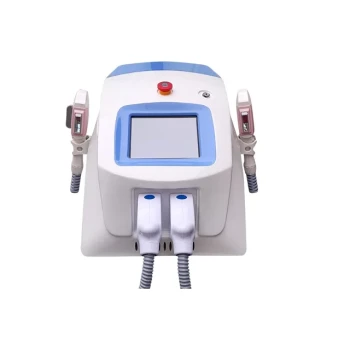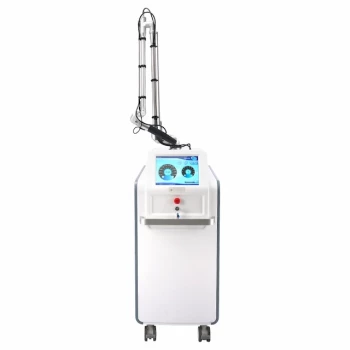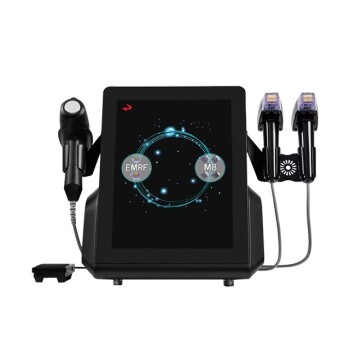Here is the direct answer: A diode laser permanently destroys the hair follicles it successfully treats, meaning those specific follicles will not grow hair again. However, it is clinically defined as causing permanent hair reduction, not total hair removal, because it can only treat hairs in their active growth phase and cannot prevent new follicles from forming later in life due to hormonal changes.
The core misunderstanding is the difference between a treated follicle being gone forever and all hair in an area being gone forever. While diode lasers permanently disable the follicles they hit, achieving a smooth, hair-free result requires multiple sessions and may involve future touch-ups to address new hair growth.

How Diode Lasers Achieve "Permanence"
To understand the results, you must first understand the mechanism. The process is precise, targeting the biological structure responsible for hair growth.
Targeting Melanin in the Follicle
Diode lasers emit a highly concentrated beam of light at a specific wavelength (typically 808nm or 810nm). This light is selectively absorbed by the melanin (pigment) within the hair shaft and follicle.
The Principle of Selective Photothermolysis
When the melanin absorbs this light energy, it instantly converts to heat. This process, known as selective photothermolysis, generates intense, localized heat that travels down the hair shaft to the base of the follicle.
What "Destroyed" Actually Means
This heat effectively damages the key structures responsible for hair growth, including the hair bulb and papilla. A follicle that has been "appropriately and completely treated" is thermally destroyed and rendered incapable of producing a new hair. This effect is permanent for that specific follicle.
The Critical Factor: The Hair Growth Cycle
The main reason "permanent removal" is not the correct term is that laser treatment is only effective during one specific phase of the hair's life.
The Anagen Phase (The Growth Phase)
The laser is only effective when the hair is in the anagen phase. During this stage, the hair is actively growing and physically connected to the follicle's base (the papilla), allowing the thermal energy to travel down and destroy it.
The Catagen and Telogen Phases (Resting Phases)
Hairs in the resting (catagen) or shedding (telogen) phases are not firmly attached to the papilla. The laser may heat the hair, but the thermal energy will not effectively transfer to and destroy the follicle's growth center. These follicles will eventually cycle back to the anagen phase and grow a new hair.
Why Multiple Sessions Are Non-Negotiable
On any given day, only about 10-20% of your body hair is in the anagen phase. Therefore, a series of treatments, typically spaced 4-8 weeks apart, is essential to systematically target and destroy each follicle as it cycles into its active growth phase.
Understanding the Trade-offs: Permanent Reduction vs. Removal
Setting realistic expectations is crucial for a successful outcome. The terminology used by regulatory bodies and clinicians reflects the biological reality of the process.
The FDA's Definition
The U.S. Food and Drug Administration (FDA) has cleared laser devices for "permanent hair reduction." This is defined as a significant and stable long-term reduction in the number of hairs regrowing after a treatment course.
What Realistic Results Look Like
For most people, a full course of diode laser treatments results in a 70% to 90% reduction in hair in the treated area. Any hair that does regrow is typically much finer, lighter in color, and grows significantly slower.
The Role of Hormones and New Growth
Your body can activate dormant hair follicles and create entirely new ones over time due to hormonal shifts. Events like pregnancy, menopause, or conditions like PCOS can trigger new hair growth years after your initial treatment series is complete. This is not regrowth from treated follicles, but new hair from previously inactive or new follicles.
The Need for Future Maintenance
Because of these factors, most individuals require occasional maintenance or "touch-up" sessions (perhaps once a year) to target new hair growth and maintain a state of maximum hair reduction.
Making the Right Choice for Your Goal
Diode laser is a powerful technology, but its effectiveness depends entirely on your goal.
- If your primary focus is a dramatic, long-term decrease in hair density: Diode laser is one of the most effective methods available, as it permanently destroys the follicles it treats during the growth phase.
- If your primary focus is 100% hair removal with zero future maintenance: You must adjust your expectations, as no laser method guarantees this outcome due to hair cycles and hormonal factors.
- If you are looking for the most efficient and cost-effective result: Committing to the full series of recommended sessions is non-negotiable to ensure you target the maximum number of follicles over their complete growth cycles.
Understanding this distinction empowers you to see diode laser not as a single magic wand, but as a powerful, long-term strategy for managing unwanted hair.
Summary Table:
| Key Aspect | Explanation |
|---|---|
| Mechanism | Targets melanin in hair follicles with laser light, converting it to heat to destroy the follicle's growth center. |
| Permanence | Follicles successfully treated during the active growth (anagen) phase are destroyed permanently. |
| Realistic Goal | Clinically defined as permanent hair reduction, not 100% removal, due to hair cycles and hormones. |
| Typical Results | A full treatment course typically achieves a 70-90% reduction in hair growth. |
| Maintenance | Occasional touch-up sessions may be needed to manage new hair growth triggered by hormonal changes. |
Achieve Dramatic, Long-Term Hair Reduction with Professional Diode Laser
Ready to transform your hair removal strategy? At BELIS, we specialize in professional medical aesthetic equipment, providing advanced diode laser systems to medical aesthetics clinics and premium beauty salons. Our technology ensures precise, effective treatments for your clients, helping them achieve significant, long-lasting results.
Partner with BELIS to offer:
- Advanced Technology: State-of-the-art diode lasers for effective, permanent follicle destruction.
- Client Satisfaction: Empower your clients with realistic expectations and outstanding outcomes.
- Business Growth: Enhance your service offerings with trusted, professional-grade equipment.
Let's discuss how our diode laser solutions can benefit your practice. Contact our experts today for a personalized consultation!
Visual Guide

Related Products
- Diode Tri Laser Hair Removal Machine for Clinic Use
- Trilaser Diode Hair Removal Machine for Beauty Clinic Use
- Clinic Diode Laser Hair Removal Machine with SHR and Trilaser Technology
- Diode Laser SHR Trilaser Hair Removal Machine for Clinic Use
- Clinic Use IPL and SHR Hair Removal Machine with Nd Yag Laser Tattoo Removal
People Also Ask
- Does laser hair removal destroy stem cells? The Key to Permanent Hair Reduction
- How often should you get laser hair removal for best results? The 4-6 Week Rule Explained
- Who is not suitable for laser hair removal? A Safety Guide to Assess Your Candidacy
- How to get the most out of laser? Maximize Your Hair Removal Results Safely
- Does laser hair removal tighten your skin? The Truth About Collagen and Hair Removal



















